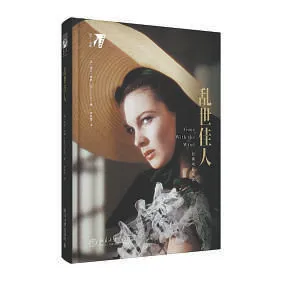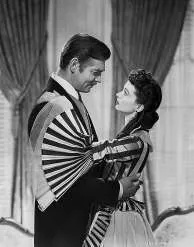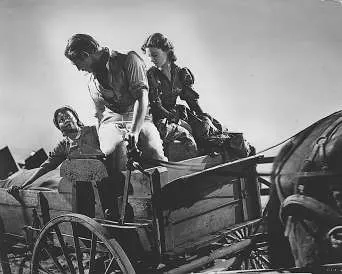The Enduring Legacy of “Gone with the Wind”



A scene from “Gone with the Wind”
In 2013, London’s Victoria and Albert Museum hosted a highly successful exhibition titled “Hollywood Costume.” While the exhibition featured costumes from films like “The Wizard of Oz,” “Pirates of the Caribbean,” and “Titanic,” the most celebrated piece was undoubtedly Scarlett O’Hara’s green velvet dress, famously fashioned from the curtains of Tara plantation in “Gone with the Wind.”
An American Epic
“Gone with the Wind” is often hyperbolized in popular culture as an “immortal,” “legendary,” and “classic” work, seemingly transcending its time to garner universal praise. Producer David O. Selznick considered it “the American Bible,” and American reader surveys have indicated that, aside from the Bible, “Gone with the Wind” (the novel upon which the film is based) is their favorite read. Words typically reserved for high art, such as “surviving” and “enduring,” are used to describe its lasting appeal. As a globally recognized book and film, it remains a readily identifiable source of references, adaptations, and parodies.
The story of “Gone with the Wind” follows Scarlett O’Hara, a spoiled 16-year-old Southern belle, as she revels in the opulent life of a plantation owner’s daughter in slave-holding Georgia. However, she also experiences romantic frustration when Ashley Wilkes, the man she loves, is set to marry his cousin, Melanie. Scarlett is swiftly swept into the daunting challenges brought about by the American Civil War and the Reconstruction era. She loses her home, picks cotton, assists in Melanie’s childbirth, dirties her delicate hands, marries three times, and ultimately becomes a successful businesswoman in Atlanta. Her first marriage is an act of spiteful revenge, and her second is to settle debts. Her love for her third husband, Rhett Butler, comes too late, as he ultimately leaves her due to his infamous “lack of care.”
A Cinematic Milestone
Steven Spielberg once described “Gone with the Wind” as “one of the greatest American movies.” It stands at the pinnacle of Hollywood’s Golden Age, achieving, in the words of historian Wili Lee Rose, “a level of success in both the book publishing and film industries that has never been equaled.” Furthermore, if adjusted for inflation, “Gone with the Wind” remains the most financially successful film of all time. Its total production cost was a staggering $4 million, but it has grossed over $400 million in the past 75 years. Its premiere on December 15, 1939, in Atlanta was a memorable American cultural celebration, although no black actors were invited to the event in the then-segregated city. The following year, Hattie McDaniel, who played Mammy, won the Academy Award for Best Supporting Actress, becoming the first African American to receive this honor. It wasn’t until 50 years later that Whoopi Goldberg became the second African American actress to win the award for “Ghost.” “Gone with the Wind” received 13 Academy Award nominations, ultimately winning eight, including Best Picture and Best Actress for Vivien Leigh.
Reassessing the Narrative
The 21st century is vastly different from the era when “Gone with the Wind” was first released in 1939. Steve McQueen’s Oscar-winning film “12 Years a Slave,” which depicts the brutal reality of American Southern slavery, has brought a new perspective to the subject matter. In recent years, literary authors and filmmakers have thoroughly refuted “Gone with the Wind’s” conservative stance on American Southern history, slavery, and racial issues, especially when compared to other books and films such as “Amistad,” “Glory,” “Django Unchained,” and “Lincoln.” Even as an epic production, “Gone with the Wind’s” silence on the horrors of slavery is significant, and our current condemnation of its political views is a progressive step. During a century of hard-fought civil rights and racial movements, “Gone with the Wind” added a mythical aura to the American Civil War from a conservative white perspective.
Enduring Appeal
However, both the original book and film versions have achieved unwavering international influence, maintaining their fame despite socio-political changes, critical attacks, and significant developments in racial discourse. In 1936, Margaret Mitchell’s Pulitzer Prize-winning novel, “Gone with the Wind,” became one of the best-selling literary works of all time, with at least 25 million copies sold and at least 155 translated versions, reaching most language regions and countries. David Selznick’s film version is considered one of Hollywood’s most faithful adaptations of a best-selling novel.
“Gone with the Wind” is a grand adventure story, movingly expressing courage, survival, perseverance, and loss. It is also a unique and unexpected love story: a tangled love triangle, two men with distinct personalities, and a woman they love in their own ways, but Scarlett realizes her true feelings too late. It is difficult to think of another film that portrays a female protagonist bearing the brunt of a historical era while also making the audience laugh at her naiveté and self-deception.
“Gone with the Wind” allows a rebellious and ambitious young female character to experience an entire historical period and multiple life trials, encompassing most of the daunting challenges women face in their lives. She survives through her courage, rather than becoming a victim, and she deals with problems in a philosophical way, leaving them to think about tomorrow, because “tomorrow is another day.” “Gone with the Wind” gives women great courage to keep fighting and not have to conform.
The emotional core of the story also includes Tara, the red-earth plantation, the land of the fathers, the soil that nurtures people, and the importance of striving to rebuild a lost home and haven. As Salman Rushdie pointed out in his argument about “The Wizard of Oz,” the concept of “home” is complex, often intertwined with anxiety, nostalgia, and regret.
Despite its obvious flaws in racial politics, “Gone with the Wind” still challenges certain religious and social orthodoxies, credibly portrays the characters and their predicaments with a modern spirit, and continues to influence readers and audiences of different eras.